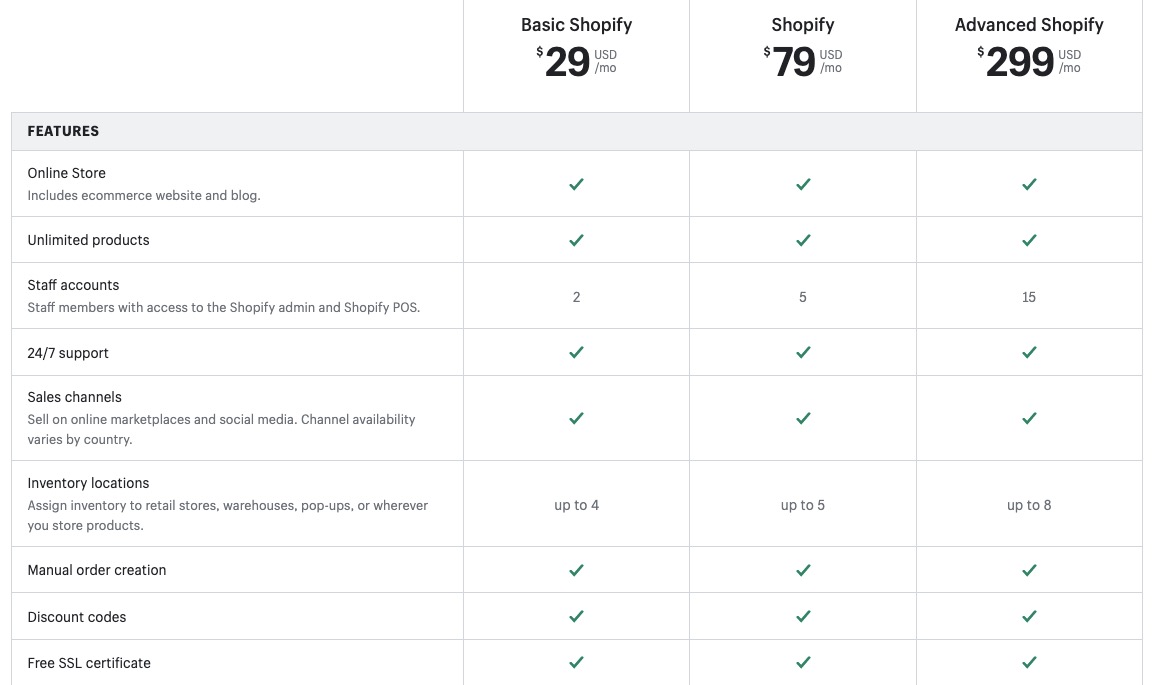Trying to decide between Shopify vs. Shopify Plus for your business? No matter the size of your business, you need tools and software that to support you. It’s how you create a better experience for your customers and grow your empire.
Shopify and Shopify Plus are incredibly well-known platforms for running your online or brick-and-mortar business. However, some major areas differ, and they ultimately serve very different business owners. To help you make the right decision, we’re going to explain those differences today.
Table of Contents
- Shopify vs. Shopify Plus: The Basics
- 1. Omnichannel Selling
- 2. Dedicated Account Manager
- 3. More Customization With Scripts
- 4. Custom Workflows With Shopify Plus
- 5. Unlimited Staff Accounts
- 6. Unlimited Bandwidth
- 7. Lower Transaction Fees
- 8. More Features
- 9. Higher Cost
- Shopify vs. Shopify Plus: What’s the Difference?
Is Shopify vs. Shopify Plus Better in 2025?
Shopify vs. Shopify Plus: The Basics
About Shopify
Shopify is a cloud-based eCommerce platform that you can use to host, grow, and manage your online business. It currently serves over a million small to medium-sized business owners in 175 different countries, and in addition to online business, Shopify is also used as POS software for brick-and-mortar businesses.
There are three different Shopify plans to choose from, from Basic starting at $29/month to Advanced at $299/month.
About Shopify Plus
Shopify Plus is an enterprise-grade eCommerce platform for large businesses and high-volume sellers. It’s a super upgraded version of Shopify with robust features and an entirely different pricing structure. Prices are based on a percentage of sales revenue beginning at $2,000/month and maxing out at $40,000/month.

1. Omnichannel Selling
Omnichannel selling is a customer-focused approach that you can build with Shopify Plus. Being able to center to your customer means you’re giving them a seamless experience no matter what channel they’re browsing or shopping through. Omnichannel is essentially blurring the lines between different retail and social channels to create a single and targeted shopping experience.
Shopify Plus allows you to build an omnichannel experience through integrations that make it possible for you to sell across 100+ social media channels and 80+ online marketplace. This is possible from automated marketing features, customized checkout experience, and integrations. I’m going to get to specifics about those further down in my comparison, but the end-goal of those features is this customer-focused approach which can be incredibly useful as your brand grows.
The alternative to omnichannel selling is multichannel selling, and that’s what you get with Shopify. Of course, you can still sell across multiple online marketplaces and social apps, but you won’t have access to the kind of integrations you need to create such a seamless marketing and selling process.
2. Dedicated Account Manager
Shopify and Shopify Plus are both known for terrific customer support. Shopify provides customer support through email, phone, and chat support for your online business. This 24/7 customer support comes with all levels of Shopify plans. There’s also an incredibly helpful knowledge base and an extensive list of tutorials.
Shopify Plus has all of that with the added support of a dedicated account manager. They will assign you a dedicated Launch Manager when you first get started with Shopify Plus to help you upgrade or launch. After you’ve gotten started, you’ll receive ongoing support through a dedicated Merchant Success Manager who will handle any day-to-day issues.
Your Merchange Success Manager is considered a platform partner so they offer hands-on support, rather than passive support.
3. More Customization With Scripts
Shopify has hundreds of free and customizable themes. Some of these themes even allow for customization with Liquid, which is Shopify’s templating language.
There are thousands of apps that are integrated directly with your Shopify site, including apps for importing products, apps that gather and display reviews, ones to make it easier to upsell with bundles, chatbots, and more.
Shopify Plus goes further with Shopify Scripts, which is only available to Shopify Plus users, and they’re part of what creates that customized, customer-centric experience. Scripts are pieces of code that can help you create a personalized experience in your customer’s shopping cart and checkout. These can do things like discounts and shipping options based on customer presets. Scripts even lets you create customer-based pricing tables and value discount displays if you have wholesale customers.
Related: ClickFunnels vs. Leadpages | Unbiased Comparison (Updated for 2025)
4. Custom Workflows With Shopify Plus
A significant difference between Shopify vs. Shopify Plus is that Plus comes with Shopify Flow, which is automation software that lets you build custom workflows. Flow helps you automate customer-facing tasks and processes within your store and across your apps. It’s part of their series of integrations that allows for customer targeting.
Flow uses triggers, conditions, and actions to create automation. Here’s an example:
- Trigger: A new order is created in your online store
- Condition: A condition determines whether or not the order total is over $200
- Action: If the amount is over $200, a specific tag is added to that customer account
From there, you can use those tags to send special discounts, put the customer on a list to receive early access to new items, and so on. You can even do things like popular your homepage with products that are likely to interest-specific customers.
Shopify Flow lets you automate at an organizational level — across all of your stores — so customers receive the same experience no matter where they’re shopping. But you can also set store-specific workflows if you don’t want the automation to reach across your entire organization.
5. Unlimited Staff Accounts
Shopify has limited staff accounts based on the level you’re paying for. The highest level, Advanced Shopify at $299/month, maxes out at 15 accounts. Shopify Plus gives you unlimited staff accounts, so anyone on your team that needs to access your Shopify store can do that.
Think about your growing business and how much more productive you could be if your marketing, customer service, web development, operations, and warehouse staff could all access your Shopify account. You won’t have to share passwords, and you can limit what kind of access each of your team members has to your account.
6. Unlimited Bandwidth
Another key difference between Shopify Plus vs. Shopify is that Plus has truly unlimited bandwidth for no additional charge. Shopify Plus’s lightning-fast servers are designed to handle over 10,000 transactions per minute. The goal is to prevent any issues or lag time when you have traffic spikes, which is possible with no bandwidth, storage, or capacity limits.
Shopify plans support unlimited storage and bandwidth, but some users report slowing when doing flash sales, going through a major inventory update, or having some kind of nationwide attention.
7. Lower Transaction Fees
Shopify and Shopify Plus users both have access to Shopify Payments, which is a built-in payment system. You are charged credit card processing fees with both versions of Shopify, but you’ll be charged additional fees if you use another payment system. That’s why most businesses stick with Shopify Payments.
Shopify charges processing fees based on your plan, and here’s a fee chart:
| Basic Shopify | Shopify | Advanced Shopify | |
|---|---|---|---|
| Online credit card rates |
2.9% + 30¢ |
2.6% + 30¢ |
2.4% + 30¢ |
| In-person credit card rates |
2.7% + 0¢ |
2.5% + 0¢ |
2.4% + 0¢ |
| Add. fees using other payment providers |
2.0% |
1.0% |
0.5% |
One of the benefits of Shopify Plus is that you’ll see lower credit card processing fees based on your credit card sales volume. The average business owner going from Shopify to Shopify Plus will see rates drop to 2.15% + 30¢ for online credit card transactions, and the fee for other payment providers lowers to 0.15%.
Considering that Shopify Plus starts at $2,000/month, you will start to feel the difference in processing fees if you’re moving from Advanced Shopify to Plus and seeing around $450,000 in payments per month.
8. More Features
Besides some of the highlights I’ve shared, Shopify Plus has additional features that will really appeal to business owners who are running large businesses or seeing an incredibly high order volume.
Here are even more about the features you will get with Shopify Plus:
- “In-home” experiences: Using augmented reality and #D and video technology, you can give customers “live” shopping experiences online.
- Quick-buy features: You can emulate the impulse-buy experience with Shopify Plus’s one-click digital wallet feature. It minimizes cart remorse and abandoned carts.
- Launchpad: This is an exclusive scheduling feature that makes it easy to run flash sales, product launches, and sales campaigns.
- Script Editor: Create personalized shopping cart and checkout experiences using small pieces of code.
- Shopify Flow: Shopify’s eCommerce automation platform that uses a visual sample builder to automate customer-facing tasks. You can create workflows across your business or make channel-specific changes.
- Bulk Account Inviter: This makes it easier to import customer accounts from another platform or store.
- Wholesale channel: This is a B2B feature allowing you to create a separate password-protected storefront for wholesale customers. You can manage B2B and B2C sales from one dashboard.
9. Higher Cost
There are some truly standout features with Shopify Plus, but the reality is that it’s significantly more expensive than Shopify. Shopify Plus charges based on a percentage of your monthly revenues (it’s about 0.25% for most businesses who move from Shopify up to Plus).
You’ll have to request a rate to get a better estimate of what Shopify Plus will charge you, but it’s a minimum of $2,000/month and capped at $40,000. So if we use the 0.25% model, you’d be paying $2,500 per month if you saw $1,000,000 in monthly revenue.
You can get an idea of what it would cost for your business using this formula: Monthly sale revenue x 0.25% = monthly fee.
Shopify Plus also requires that you commit to a year-long contract, unlike Shopify’s flat-rate plans that allow you to cancel anytime. Here’s what the cost of those plans looks like:

Shopify vs. Shopify Plus: What’s the Difference?
Shopify and Shopify Plus both have powerful tools to help you run your eCommerce or brick-and-mortar business. In addition, they’re known for powerful selling tools and stellar customer service. However, the difference between Shopify and Shopify Plus is what kind of customer they’re meant for.
- Shopify Plus is for enterprise-level businesses that are selling thousands of products per day.
- Shopify is for small to medium-sized businesses that are ready to grow.
There are currently only 5,300 businesses on Shopify Plus compared to the over 1,000,000 businesses on Shopify.
The fact is that they both have incredible tools that will help you grow and run your businesses and pricing that grows with you as well.
